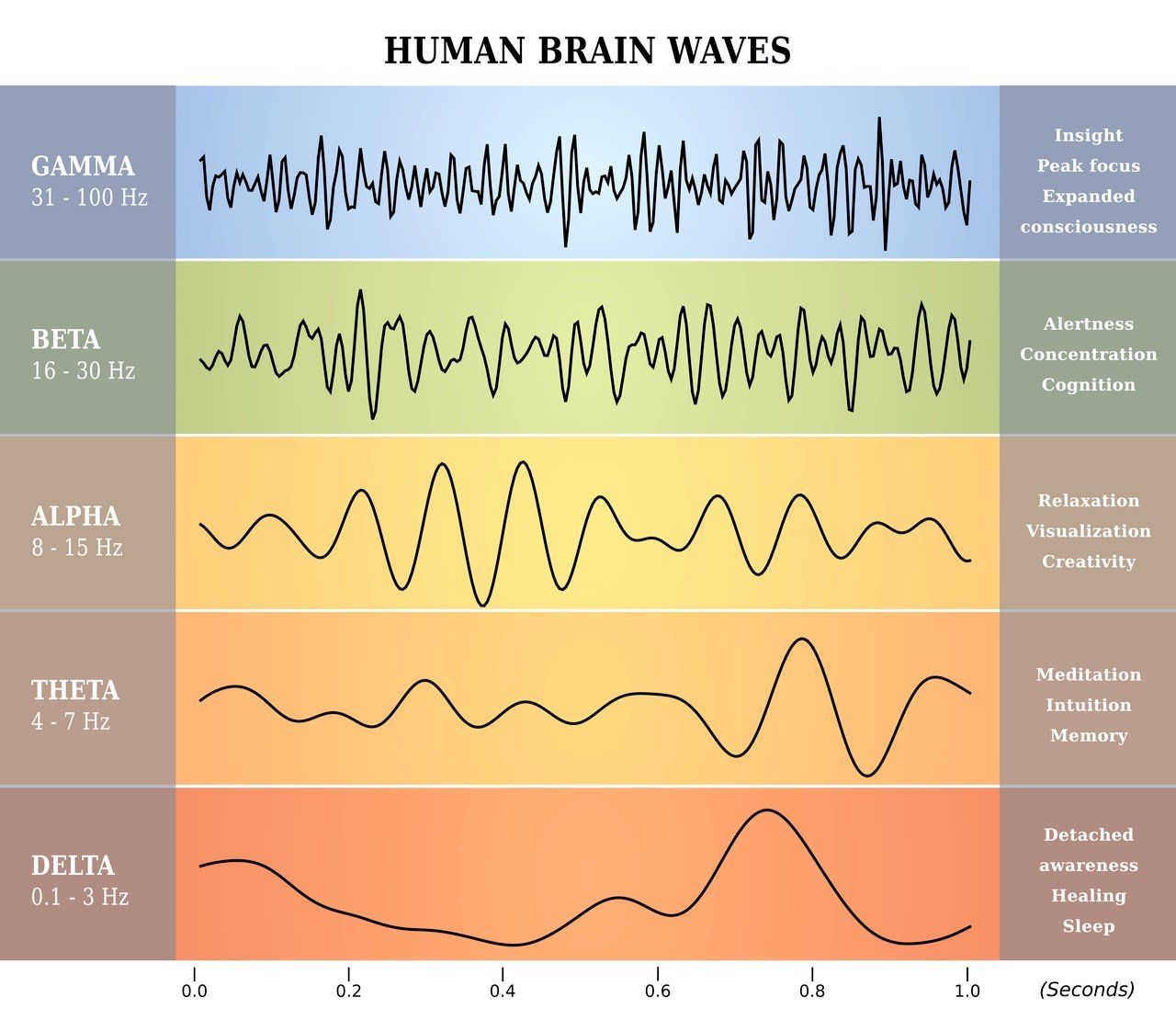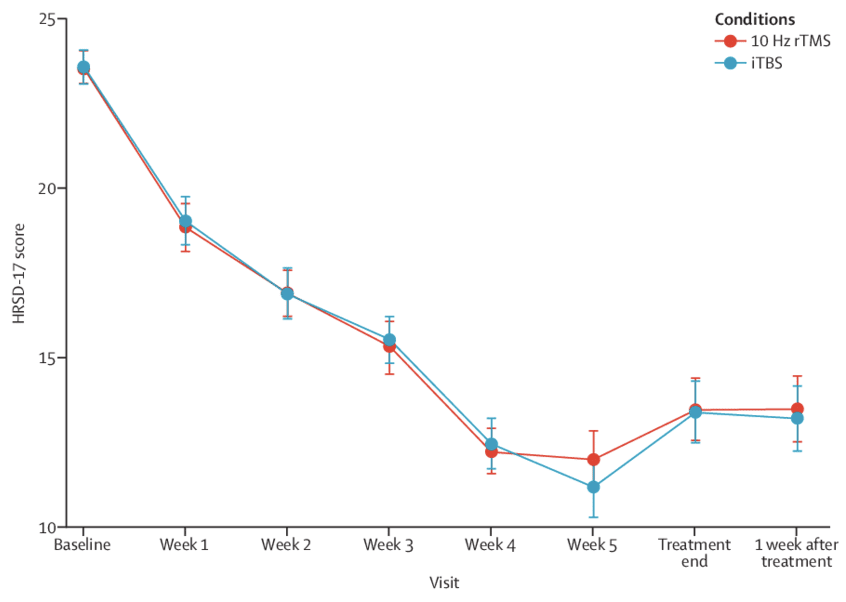Intermittent Theta Burst Stimulation (iTBS)
A next-generation TMS protocol — same efficacy, shorter sessions.
What is iTBS?
Intermittent Theta Burst Stimulation (iTBS) is a patterned form of transcranial magnetic stimulation (TMS) that delivers bursts of pulses in a way that mimics the brain’s natural theta rhythm (5 Hz). Unlike traditional 10 Hz rTMS, iTBS provides the same therapeutic benefit in a fraction of the time — typically just over 3 minutes per session instead of 19–37 minutes.
How iTBS Works
Burst Principle
Each burst contains three pulses at 50 Hz, repeated at 5 Hz (the brain’s theta frequency).
Train Delivery
2-second trains of bursts followed by 8-second rests (“intermittent”).
Time-Efficient Dose
Only 600 pulses per session (vs. 3000 with standard TMS) while maintaining equal effectiveness.
Neuroplasticity
Theta-patterned stimulation taps into the brain’s learning and memory mechanisms for durable change.
Clinical Evidence & FDA Clearance
In 2018, the FDA cleared iTBS following the landmark THREE-D trial, which showed iTBS is non-inferior to 10 Hz TMS for Major Depressive Disorder (MDD). Translation: at least as effective as traditional TMS, with much shorter daily visits.
Benefits of iTBS
- Time Savings:~3-minute sessions mean less time in the chair and easier scheduling.
- Comparable Efficacy: Equal effectiveness to standard 10 Hz rTMS for depression.
- Potential for More: Higher pulse counts (e.g., 1800 pulses in accelerated research protocols) show promise for even greater effectiveness.
- Accelerated Options: iTBS paved the way for advanced accelerated protocols like ONE-D and SAINT.
Who Can Benefit?
- Adults with Major Depressive Disorder, including treatment-resistant cases.
- Patients seeking a faster, more convenient option than standard TMS.
- Those who have not responded well to medications or experienced side effects.
iTBS vs. Standard 10 Hz TMS
| Feature | iTBS | Standard TMS |
|---|---|---|
| Session length | ~3 minutes | 19–37 minutes |
| Pulses per session | 600 | 3000 |
| FDA clearance | Yes (2018, MDD) | Yes (2008, MDD) |
| Efficacy | Equal (THREE-D trial) | Established |
| Convenience | Very high | High |
Note: Individual results vary. Your physician will tailor the protocol to your clinical profile.
Safety & Side Effects
- Common: Mild scalp discomfort, tingling, or transient headache early in treatment.
- Rare: Serious adverse effects are uncommon when protocols are followed.
- Devices: Not all TMS systems can deliver iTBS; our FDA-cleared systems are optimized for this pattern.
Cost & Insurance Coverage
- Most major insurance plans accepted(including Medicare, Cigna, Aetna, UnitedHealthcare, and Blue Cross Blue Shield).
- Pre-authorization support: We help handle documentation and medical necessity reviews.
- Cash options & financing are available.
- Transparent pricing: aligned with our TMS Cost page.
Coverage typically applies for Major Depressive Disorder when criteria are met. Coverage for other conditions may vary by plan. Contact us and we’ll verify your benefits before starting.
Why Choose Florida TMS Clinic?
- Physician-led, evidence-based care.
- Both Tampa and Wesley Chapel locations equipped for FDA-cleared iTBS.
- Flexible scheduling with shorter daily visits.
- Insurance and financing support.
Get iTBS Near You
iTBS in Tampa, FL
Our Tampa clinic offers physician-led, FDA-cleared TMS and iTBS protocols tailored to your needs.
iTBS in Wesley Chapel, FL
Our Wesley Chapel clinic provides the same high-quality iTBS treatment close to home.
Locations
Tampa Clinic
2805 W Busch Blvd, Suite 208
Tampa, FL 33618
Phone:(813) 867-3646
Wesley Chapel Clinic
26843 Tanic Dr, Suite 101
Wesley Chapel, FL 33544
Phone:(813) 867-2378
Explore More
Overview of Repetitive Transcranial Magnetic Stimulation.
TMS stands for transcranial magnetic stimulation. Transcranial means “through the skull,” and magnetic stimulation means that the magnetic field will penetrate through the skull and cause activation of the brain cells underneath without causing any harm while doing so. Whoever came up with the name transcranial magnetic stimulation was trying to explain how it works. Unfortunately, it made it a little bit confusing for the general public to understand transcranial magnetic stimulation. For this reason, I prefer terminology like magnetic brain therapy. The classical form of transcranial magnetic stimulation applies a magnetic field similar in power and intensity to the magnetic field used in an MRI machine to the area of the brain called the DLPFC or the dorsolateral prefrontal cortex.
Read more on How TMS therapy works.
The magnetic pulses are delivered at a frequency of 10 Hz, meaning that 10 pulses per second. Each train of pulses is delivered for 4 seconds. This means each train of pulses is 40 pulses. A break between the trains of pulses is between 11 to 26 seconds. Then a new train of pulses comes along for another 10Hz X 4 Seconds = 40 pulses. This is repeated for 75 trains. By doing the simple math, we can find out that we deliver 10 (Hz) X 4 (Sec) X 75 (Trains) = 3000 pulses. So technically, the patient is receiving 3000 pulses of stimulation each session. This particular stimulation of the brain cells will activate this area of the brain in the frontal lobe, which is connected to the limbic system.
Learn about the pros and cons of TMS
The limbic system is where we feel emotions, pain, depression, sadness, enjoyment .. etcetera. Waking up the cells that connect to the limbic system could improve depressive symptoms in over half of the patients who are going through TMS. Just like when somebody goes to the gym to build muscle mass, they're not going to lift weight only once and expect to be bodybuilders for the sudden.
Learn more about TMS patient experiences.
They probably would need to do it in sets, and they would need to do it daily for a while before they start building muscle tissue or muscle mass. A similar idea applies to brain stimulation with TMS. You can just use the simulating magnetic pulses for one day and expect that the brain will maintain this stimulation. You will need to do it daily, five days a week, for six weeks, for a total of 30 treatment sessions. The chances of someone with treatment-resistant depression responding to this protocol is about 58%, which is significantly better than medications at this stage of the depression course.
The question then is how to make TMS even better. The pursuant of a better TMS led us to theta-burst stimulation.
What is theta wave?
Theta wave frequency refers to the frequency of brain waves in the range of 4 to 7 Hz. Some brain circuits use this particular frequency as an oscillation wave. Theta frequency is the language that the brain circuits used to speak to each other. Mainly it is the oscillation frequency used by the hippocampus to connect to other brain circuits. Theta frequency is observed when the brain forms memories, deep meditation, or specific sleep phases. In other words, it seems like when the brain wants to create long-lasting skills; it uses theta frequency. For this reason, it was suggested that by using the same frequency in stimulation, the brain could be more effective and more efficient.
Learn about TMS for anxiety
What is theta-burst stimulation?
Theta-burst stimulation is a form of transcranial magnetic stimulation that uses theta frequency to stimulate the brain. Using the same frequency that the brain uses to communicate with its internal circuits, we might be more effective and time-efficient.
With theta-burst stimulation, we deliver a triplet of pulses at a frequency of 50 hertz for 200 milliseconds intervals for a train duration of 2 seconds which means a total of 10 triples of pulses in 2 seconds. This is a total of 30 pulses. Because those 10 bursts of pulses are delivered in 2 seconds trains, this gives it a frequency of 5 Hz, which is in the range of what we called above theta wave frequency, the frequency used by the hippocampus to communicate with other circuits of the brain. Because this is more effective in stimulating the brain, we don't need to do it for 75 trains, and we could just get away with 20 trains. Also, the interval between the trains is only 8 seconds, saving even more time. Doing the math here, it means that you were giving 3 (triplet pulse) X 5 (Hz) X 2 (Sec) X 20 (trains) = 600 pulses.
Success rate of TMS therapy?
Click here to learn more.
Similar to rTMS. We need to do iTBS daily, 5 days a week, for 6 weeks, for a total of 30 treatment sessions.
How effective is theta-burst stimulation?
Some researchers believe that theta-burst stimulation is even more effective than 10 Hz repetitive transcranial magnetic stimulation. We know for sure that, at least, iTBS (Intermittent theta burst stimulation) is as effective as rTMS (repetitive transcranial magnetic stimulation). This was proven in a large non-inferiority trial called the TREE-D trial, which resulted in the FDA approval for theta-burst stimulation in 2018.
The importance of theta-burst stimulation.
Theta burst stimulation opens the door wide open to other modalities of treatment like accelerated TMS. In an accelerated TMS, we can use theta-burst stimulation in multiple sessions a day to achieve the same results that we were achieving over six weeks in just about one week. Theta-burst stimulation can also decrease the cost of TMS. This is because it takes less time to treat patients, which means that one device can treat more patients a day, making the treatment more cost-effective.
There had been particular interest in theta-burst stimulation for indications other than depression. For example,
treatment of bipolar disorder, negative symptoms of schizophrenia, central pain syndrome, and fibromyalgia.
rTMS vs iTBS
This compassion table breaks down head-to-head repetitive transcranial magnetic stimulation vs. intermittent theta-burst stimulation.
| rTMS | iTBS | |
|---|---|---|
| FDA Indication | Depression | Depression |
| Efficacy | ~50% | ~50% |
| Pulses | 3000 | 600 |
| Duration | ~ 19 minutes | ~ 3 minutes (190 seconds) |
| Cost | $$$ | $$ |
| Availability | Most TMS Clinics | Some TMS Clinics |





